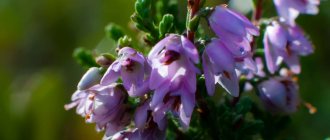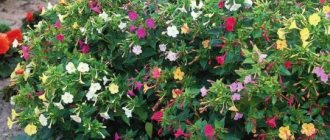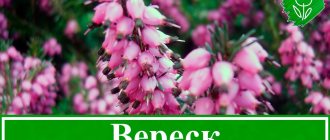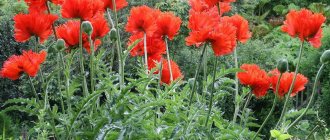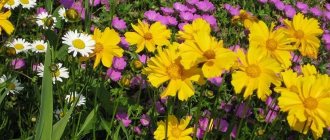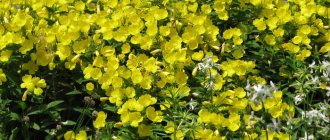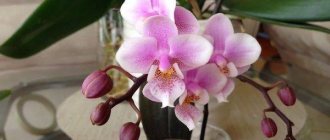This wonderful cornflower flower grows in Russia and belongs to the genus of herbs of the Compositae family. Two varieties are especially widespread: blue and meadow.
This delicate flower is always present in fields planted with grain crops - it grows not only from the edge of the field, but also between the ears of wheat and rye. According to researchers, a small number of these plants significantly contributes to improving the quality of grain harvests.
This is a biennial plant, easily propagated by self-sowing and grows up to 80 cm in height. It came to Russia along with the seeds of wheat and other grains. Cornflower leaves growing from below are different from the upper leaves. From below they are petiolate and pinnately lobed; towards the top they become linear and sessile.
Flowers are located at the top and arranged in baskets. The inflorescences in the basket, located on the edge, are sterile and have the shape of an enlarged funnel. The flowers located in the center of the basket are bisexual and form oblong-shaped gray seeds with a tail. With the help of this tail and the wind, the seeds are perfectly dispersed around the mother bush.
The flowering time of cornflower is the first half of summer. The flower is highly prolific; up to 6,000 thousand seeds grow on one bush.
Growing perennial garden cornflower
Garden cornflower perennial planting and care photo
- Prefers a place well lit by the sun, open areas, space, but easily tolerates some shading.
- Requires virtually no maintenance. Good on alpine hills, as a border plant, in flower beds.
- Unusually good when surrounded by cereals. Used for meadow-style plantings, where it is especially good in combination with white and yellow flowers.
- Excellent resistance to harsh winters. It can live for more than 10 years in one place without transplantation.
Cornflower planting
It is best to plant plants in April-May. At this time, the soil warms up superbly. It does not have any special soil requirements - it can even be planted in soil with a high lime content. Both root suckers and seedlings, as well as sections of rhizomes with buds, are placed in the ground.
Maintain a distance - it should be at least 50 centimeters. This will allow the cornflower to form a lush, beautiful bush.
After planting in open ground, the soil is pressed down slightly to fill empty cavities in the ground. Thanks to this simple technique, the plants will be able to take root well. Planting and care assume that the rhizomes will grow down and to the sides, and the bud can be buried in the ground no more than 3 centimeters.
When planting cornflowers, the soil can really be any, but it is better to choose a place that is open and well lit by the sun. Partial shade is also allowed, but in this case they will grow a little worse.
We select conditions for annual cornflowers
It is no coincidence that cornflowers in nature can most often be found in open fields. These are cold-resistant plants, not afraid of night frosts and cold snaps, and are characterized by extreme light-loving properties. You don’t have to try to grow annual cornflowers, both the favorite and most popular blue cornflower, and rarer species, without good lighting. For cornflowers, choose the sunniest locations, open, warm or even hot. In light shade, only annual soft cornflower can be grown, but it blooms much worse in places with even weak partial shade, even though it forms the most beautiful dense thickets there of leaves that seem to be covered with a silver coating.
Cornflower. © Guido Gerding
When planning plantings with cornflower, one more factor should be taken into account. For this annual, the key importance is lighting not the flowers, but the leaves. The sunlight should illuminate all the greenery evenly on a fairly small plant. That is why, when planting in mixed compositions with perennials and annuals, annual cornflowers are always placed in the foreground (regardless of the height of the variety). This strategy is ideal for ensuring that the sun's rays reach even the lower part of the plants. For the same reason, cornflowers cannot be used in dense plantings and dense ridges; partners are carefully selected for them, most often combined with low-growing plants than with other large annuals and perennials.
To achieve abundant and long-lasting flowering, you will have to take care to provide cornflowers with the highest quality soil, treated and of medium nutrition. This annual plant will produce a large number of spectacular and large flowers only on fertile (but not overly rich in humus) and well-drained soil that is neutral in its characteristics. It is better to avoid calcareous or excessively acidic soils for cornflowers, as well as compacted or too dry, crumbly, rocky soil.
The minimum distance comfortable for these plants is about half a meter for standard medium and tall varieties of blue cornflower. Only such a distance and the presence of free soil around will allow the plants not to darken each other. There are no special rules for planting annual cornflowers.
Cornflower. © Dalgial
Description and types of cornflower
Garden cornflower is a beautiful, simple flower that does not require special care. It can be annual, biennial or perennial. The colors are completely different: blue, purple, yellow, pink, white, depending on the variety.
White cornflower is listed in the European Red Book as a rare endangered species.
Field cornflower, on the contrary, is a weed. They are actively fighting him. This type of weed infests rye and is dangerous to horses.
In general, cornflower grows up to 1.2 m!
Varieties of cornflower
In nature there are a large number of different varieties of this flower. They differ primarily in the shape of the flower basket, color and stem height. Let us describe the types that are most common.
Cornflower blue
In our country it is also called the voloshka, the ragwort and the cyanosis. It grows with straight stems, the height of which is 80 cm. The flowers are blue or azure, arranged in sparse baskets, blooming from the beginning of summer until the first frost.
The gray-green leaves are rough to the touch, the lower ones have petioles, but the higher the leaves are located on the stem, the more they change their shape to that of a lily.
White
These are perennial flowers of very low stature, barely reaching 25 cm. With beautiful double flowers, they are collected in elastic baskets with a diameter of about 4 cm. This rare type of flower is included in the Red Book.
Mountain
This is a plant with a creeping rhizome with a tall stem growing up to 80 cm in height. The leaf blades are grey-green and elongated. The outer flowers are funnel-shaped, bright blue or light blue, the middle ones are violet-lilac. Flowers with a diameter of 7 cm.
Yellow
A flower that grows up to one meter tall. The beautiful yellow flowers are collected in baskets with a diameter of 5 cm. The stems of the plant are straight and thick, so they retain their decorative appearance even after a strong wind.
Large-headed cornflower
This species looks like a shrub, since its stems reach 120 cm. In addition, it has very large inflorescences, 7 cm in diameter. Blooms in July and until the end of summer.
Oriental
It is a wild flower, reaching a height of 120 cm, the leaves grow on long petioles and have yellow flower heads.
Lugovoy
This flower has a straight stem that grows up to one meter in height. The flowers are collected in purple baskets. It grows throughout the European part of the continent right up to the Urals, it can be found in meadows and fields, and even grows along highways.
Musky
This species has a beautiful aroma and comes from Transcaucasia. It is mainly grown for cutting, as it is very branched and blooms profusely, growing up to 80 cm. The leaves are green, and large baskets of flowers of various colors grow at the ends of the stems: white, yellow, lilac and purple. It propagates by self-sowing and is not picky about soil.
Whitened
It grows up to 60 cm. This is one of the beautiful species with green leaves, and the leaves located at the bottom of the bush are white. It blooms with bright pink flowers from early June until early autumn.
Spreading
This is a very spreading plant, whose height varies from 17 to 65 cm. there are a lot of baskets, but they are small, no more than 6 mm. width. Flowers, as usual, are grouped in baskets of white and pink.
Cornflower: detailed characteristics
The plant is herbaceous, but in nature there are one- and two-year-old species. The stem can be erect or practically lie on the ground, reaching a height of 120 centimeters. The leaves are entire, and the lush inflorescences form a basket. The flowers are funnel-shaped or tubular, the color is not necessarily blue. There are varieties with flowers of white, pink, yellow, and many other shades. The root system is different: from fairly long ones, resembling branches, to powerful rhizomes.
In total there are about 500 subspecies of cornflowers. They differ in stem height, structure, color and some other characteristics. Below we list the most popular types:
- Blue cornflower. Description and appearance correspond to the name. It has bright blue flowers, also available in blue. It will delight you until the end of autumn. It is popularly called voloshka, blue flower and blue flower.
- White cornflower. The calling card is white flowers, which are collected in neat inflorescences. Their diameter does not exceed 4 centimeters. It is a perennial and is included in the Red Book of Europe.
- Mountain cornflower. Perhaps the most famous of the perennial plants. Mountain cornflower is a rhizomatous plant with a 75 cm stem, gray-green leaves, bright blue marginal flowers, and purple middle flowers. The diameter of the inflorescence is up to 7 centimeters. Be sure to plant mountain cornflower on your site to transform the area and fill it with heavenly shades.
- Yellow cornflower. A perennial representative of the flora, it grows up to 1 meter. The flowers are bright yellow, no more than 5 cm in diameter. The leaves are oblong, lanceolate in shape, and the stems are straight.
- Large-headed cornflower. It differs from other “relatives” in having rather large flowers that have a light or bright yellow tint. It begins to bloom in July, the flowering period lasts 1.5 months.
- Eastern cornflower. It was first discovered back in 1759. Considered a wild plant, the yellow flowers are collected in a basket, the leaves are pinnately divided.
- Meadow cornflower. Like many other perennial cornflowers, it has lanceolate leaves and white flowers (basket). The flowers can also be lilac-pink. In Eurasia, this species is considered one of the most common.
- Field cornflower. Another fairly common type. Relatively small in height - 60 cm. Flower baskets are single. The blue marginal flowers are funnel-shaped, but the middle ones are more like a tube. Blooms all summer.
- Spreading cornflower. Among its fellows, this species is one of the lowest. In nature, there are specimens with a height of 20-30 and even 15 cm. The baskets are very small, no more than 5 mm wide, the flowers are white or pink, appear in June until September.
Description and characteristics of apple trees of the Augusta variety, cultivation, planting and care
To summarize, in gardening, annual cornflower is not in as great demand as perennials. The second option is unpretentious, reproduces very easily, and rarely gets sick. Garden perennial cornflower grows in the same place for 7 or more years.
What cornflower seeds and seedlings look like
Cornflower (Centaurea) is a herbaceous plant of the Asteraceae family, represented by several hundred species. The stems of the crop are erect; in adulthood, seedlings reach 1 m in height. The leaves are long, lanceolate, pubescent, the flowers are tubular in shape with jagged edges of the petals.
Cornflower blooms in June and remains decorative until September
The color of the buds depends on the variety and can be blue, yellow, purple or snow-white. The photo of cornflower seeds shows that they look like oblong gray boxes with pubescence at the end.
Useful properties of cornflower
Garden cornflower is used not only as an ornamental plant. It is also interesting for its medicinal properties. Honey from this plant has a beneficial effect on the stomach, intestines, kidneys and immune system.
Cornflower blue application
The leaves of the flower are used as a seasoning for meat and first courses. The plant has a spicy-sweet taste, combining the acidity of lemon, the freshness of mint and the bitterness of cloves.
The beneficial properties of inflorescences are actively used in cosmetology in the production of masks, face creams and washing liquids. Such products cleanse and rejuvenate the skin well, and are preventative against spider veins and acne.
Alternative medicine uses decoctions of stems and inflorescences as a diuretic, biliary and expectorant. Petals are included in pharmaceutical gastric preparations.
Contraindications
Due to the fact that the chemical composition of the flower contains cyanide components, taking decoctions of this plant is contraindicated for uterine bleeding and painful menstruation, during pregnancy and breastfeeding.
If it is necessary to use it for the treatment of other diseases, the medicine should be used in moderation, taking breaks, as prescribed by the doctor.
Cornflower application
There are a number of recipes in which blue cornflower is used fresh. For example, a drink made from cornflower, the recipe for which is quite simple.
5-7 grams of cornflower petals (a heaping teaspoon) is poured into a glass of boiling water and infused for half an hour.
Tea or a drink with cornflower can be drunk immediately or diluted with boiling water, like tea leaves. This remedy, thanks to the biologically active substances contained in it, will perfectly relieve headaches, fever and swelling, and quench thirst.
Tea prepared in this way perfectly stimulates the appetite if you drink it half an hour before a meal.
Blue cornflower for heart disease
Blue cornflower does an excellent job of restoring the body after heart disease. To do this, prepare an oil extract.
100 grams of herbal mass are crushed, poured with 2 glasses of vegetable oil (preferably olive) and infused in a warm place (preferably in the sun) for 20 days. It is best to use opaque, tightly sealed containers for this. The resulting mixture is filtered and taken 1 teaspoon on an empty stomach every day.
Extraction helps normalize heart pressure, relieve swelling and disinfect the body. The course of treatment is 2 months and can be repeated only after six months.
Collection for hypertension
Take 15 grams of each plant: blue cornflower flowers, chokeberry berries, yarrow, mistletoe leaves, valerian root, hawthorn fruits, horsetail.
Brew one tablespoon of the mixture with 200 ml of boiling water and leave for 30 minutes. Strain and drink 70 ml after each meal.
To relieve eye fatigue
To relieve eye fatigue, puffiness, and restore eye color, use a collection with cornflower.
Flowers of cornflower, snapdragon, eyebright and elderberry are taken in equal parts, crushed and mixed in a dry container. In a ratio of 1 to 100, the mixture is poured with boiling water and infused in a warm place (preferably in a thermos) for 6 hours.
This infusion is perfect for instillation into the eyes, for lotions that are applied to the eyes for 10-15 minutes, after which the skin should be thoroughly rinsed with warm water.
With constant use, the color of the white of the eye is restored, vision improves, and the mucous membrane of the eye is restored. Treatment is carried out in several stages, each lasting a month with breaks.
An infusion of cornflower, prepared according to this recipe, will quickly relieve eye fatigue.
Cornflower flowers - dry or fresh - are poured with boiling water in a ratio of 1 to 20 (2 tsp per glass) and infused in a warm place for 2 hours, well wrapped. Then strain and use for eye baths.
Collection to stop bleeding
Crushed dry cornflower roots are combined in equal parts with crushed yarrow and horsetail herbs. 10-15 grams of the collection (2 tablespoons) are poured with 100 grams of water (half a glass) and boiled over low heat until the liquid evaporates by half. Take 2 tablespoons every hour until the bleeding stops completely and consolidate the result over the next two days, using the same dose once a day.
Cornflower tincture with vodka
Alcohol tincture of cornflower will cope well with jaundice, genitourinary diseases, and kidney diseases.
To prepare it, you need to infuse the dry petals in vodka (100 grams per liter) for two weeks.
One tablespoon of tincture is taken before meals two to three times a day, washed down with plenty of water.
For constipation
Brew 2 teaspoons of cornflower roots with 200 ml of hot water and leave for 2 hours. Strain and take a tablespoon 3-4 times a day before meals 15-20 minutes.
Cornflower in cosmetology
Cornflower is used to rinse hair and as a lotion for wiping oily skin.
Pour a tablespoon of flowers with 0.5 liters of a mixture of vinegar and water, taken in equal proportions. Leave for half an hour and filter. Rub this mixture twice a day into the hair roots. Before going to bed, rinse your hair with plain water.
This lotion helps restore structure and strengthen hair.
To care for oily skin, prepare a lotion by steeping 50 grams of fresh petals in 0.5 liters of boiling water. Leave for an hour and strain.
Wipe your face with this lotion daily. Store in the refrigerator or freeze the cubes.
How to plant in open ground
If you want to improve abandoned areas in the garden where nothing grows, then it is best to plant cornflowers there. The garden variety of plant varieties allows you to make a corner of the garden bright and spreading fragrance.
Deadlines
Planting cornflower seeds requires warmth. It is best to sow an ornamental plant in late April or early May. The dates are shifted if the soil has not warmed up well.
Cornflowers are planted by cuttings in the fall, in mid-October.
Selecting a location
They note the unpretentiousness of garden perennial species. The main thing for cornflowers is that the site has:
- good lighting;
- loose light soil;
- neutral acidity;
- humus layer.
You can plant flowers in flower beds where partial shade does not last long. But the plant blooms better in the light.
Soil requirements
Sandy, dry soils are suitable for cornflower. The flower grows worse on clay soil. Before sowing seeds, they dig up the area and harrow it, breaking up large lumps of earth. If nothing grew in this place, then you need to apply fertilizer. You should scatter humus or compost before digging the flower bed.
Planting scheme
Flower seeds are planted to a depth of 2-3 centimeters. The distance between them should be 20-30 centimeters. Bushes should be planted so that the growth bud is at the level of the soil surface. If the roots of the cornflower are horizontal, then the bud is lowered 2-4 centimeters deep when planting. The distance between seedlings is not less than half a meter.
How to grow annual and perennial cornflower from seeds
Annual garden cornflower planting and care photo
Cornflower can become a luxurious, and at the same time, inexpensive garden decoration if you grow it from seeds. Although the flowers are best known for being blue, these annuals come in pink, white, red, lavender, and deep burgundy.
Cornflowers produce single or double flowers with a fringe of dissected petals and gray-green leaves. Dwarf varieties are suitable for edging and borders, while taller varieties are popular in cottage gardens. However, since higher varieties are difficult to obtain from local nurseries, planting cornflower seeds is the only way to propagate them in the garden. Luckily, they are easy to grow both indoors and outdoors.
- Seeds of annual species are sown in the spring in a permanent place in fertilized soil, when the soil has warmed up sufficiently.
- Perennial species are sown in an unheated greenhouse or grown as seedlings at home and transplanted in October to a permanent place.
Later they are propagated by dividing the bush or cuttings. It is best to divide perennial species after flowering, after performing low pruning. They are planted at a distance of 45 cm - this gives the plant the opportunity to independently form a beautiful shape.
Planting cornflower seeds in open ground
How to plant garden cornflowers in open ground photo
In areas with mild winters, cornflower seeds can be sown in open ground in September. They will germinate in the fall and take root to bloom in the spring. However, for colder climates, it is best to sow cornflower seeds in the spring, as soon as the weather permits. Several successive plantings of cornflower seeds will lead to almost continuous flowering throughout the growing season. This happens because annual cornflowers are not long-lived plants. A second planting in the spring is recommended if cornflower seeds are first sown in the fall.
Sow the seeds in slightly alkaline garden soil to a depth of 2-2.5 cm. You can carry out stratification: moisten the seeds and keep them in the refrigerator until germination, this is approximately seven to 10 days for annual varieties and two to three and a half weeks for perennial varieties. Sown in a bed for seedlings, the plants are then transplanted at a distance of 20-30 cm from each other.
Planting cornflower seeds for seedlings at home
Garden cornflowers: planting seeds and caring for photo seedlings
Garden cornflower seeds are sown for seedlings about a month before the last frost or a month before planting in open ground. If planted at the end of April, sow should be done at the end of March.
Fill prepared containers with soil mixture for flowers or take peat pots. Once the containers are filled, moisten the mixture and allow to drain. Then, sow three or four cornflower seeds per pot and cover with film. Place them in a warm place to allow the seeds to germinate. Shelter will create a greenhouse effect, and increased humidity and heat will promote rapid germination.
Cornflower seedlings ready for planting photo
After seed germination, the cover is removed and the containers are placed in a sunny place. When a pair of true leaves appear, the strongest plants are selected to be preserved for replanting in open ground, and the remaining shoots are pinched off at soil level. It should be fed once with a complex water-soluble fertilizer. When the height of 8-10 cm is reached, the garden cornflower seedlings are ready for planting.
Cornflower propagation
As already mentioned, it can be propagated by root cuttings. To do this, carefully dig up an old bush and, depending on its size, divide it into two or four parts with a shovel. And these parts are already seated in prepared depressions in the ground. All this can already be done at the end of April. Flowering after such a transplant will begin next summer.
The flower also reproduces well using seeds. Moreover, this reproduction occurs by self-seeding. The grown bushes can be planted in the place where the owner of the flower garden considers it best.
And don’t forget about watering after replanting; if you water it once every three days, the bush will quickly take root in the new place and grow faster.
All care comes down to watering and weed control. To stimulate abundant flowering, you need to pick off buds that have already faded.
This plant is almost not attacked by pests, but very rarely during drought without watering a spider mite attacks. If a mite is detected, tear off the obviously affected leaves of the plant and treat with Actellik. This drug has a wide spectrum of action against many pests.
Care
There is nothing complicated in caring for decorative perennials. You just need to carry out the usual procedures on time so that the plants have enough moisture, light, air and nutrition.
Watering
Moisture for flowers is necessary in moderation. Water the flower beds with cornflowers as the top layer dries. Plantings cannot be flooded, otherwise the root system will rot.
The plant tolerates a lack of watering better than its excess.
Loosening and weeding
It is necessary to constantly loosen the soil around the bushes. This is especially important after heavy rains and heavy watering.
Flowering bushes grow poorly if there are a lot of weeds nearby. It is necessary to pull them out as a source of spread of diseases and pests.
Trimming
To create a neat bush, cornflowers are pruned, removing faded buds. In spring, diseased and damaged stems are removed. Such operations will help the flower garden or flower bed look beautiful and well-groomed.
Top dressing
During the growing season, cornflowers need fertilizer. Every 2-3 weeks the bushes are fed with mineral fertilizer complexes. Before wintering, be sure to add compost, humus, potassium salt and superphosphate to the soil. You can feed cornflowers with wood ash.
How to make your own border


